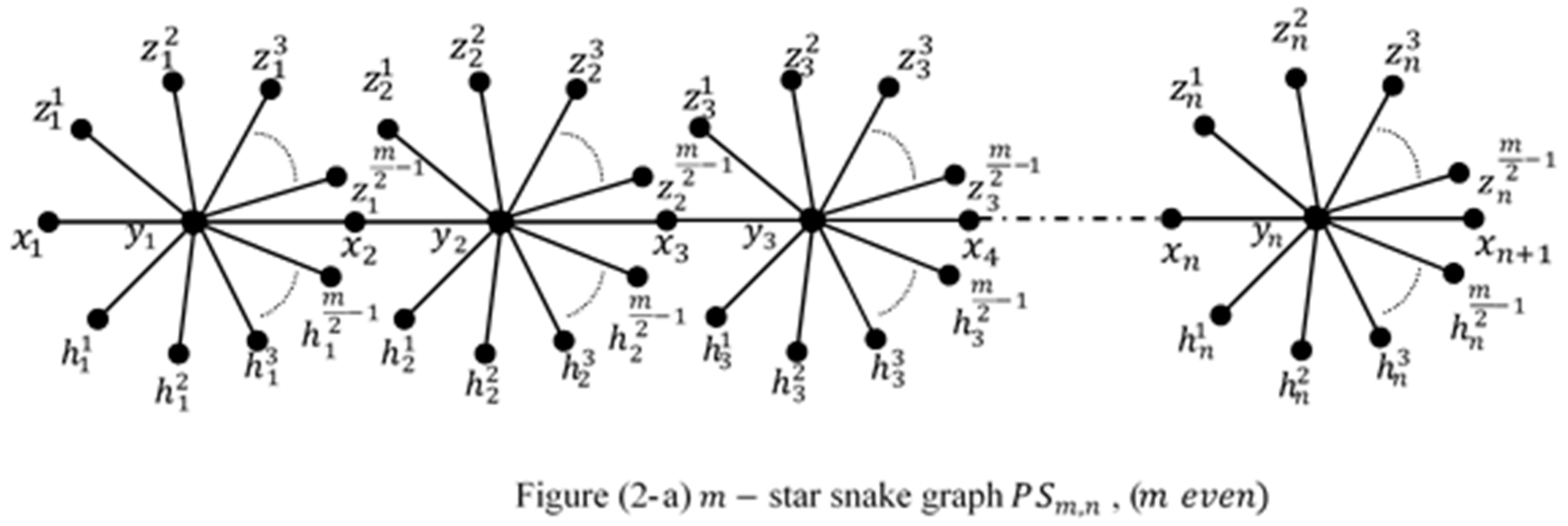Submitted:
04 November 2023
Posted:
06 November 2023
You are already at the latest version
Abstract
Keywords:
1. Introduction
2. Main results:





3. Conclusions
Acknowledgment
Conflict of Interest
References
- Bača, M.; Jendroî, S.; Miller, M.; Ryan, J. On irregular total labellings, Discrete Math., 307 (2007), 1378–1388. [CrossRef]
- Ivanĉo, J. ; Jendroî, S.Total edge irregularity strength of trees, Discussiones Math. Graph Theory, 26 (2006), 449–456. [CrossRef]
- Ahmad, A.; Siddiqui, M. K. ; Afzal, D. On the total edge irregularity strength of zigzag graphs, Australas. J. Comb., 54 (2012), 141–149.
- Ahmad, A. ; Arshad, M.; Ižaríková, G. Irregular labelings of helm and sun graphs, AKCE Int. J. Graphs Combinatorics, 12 (2015), 161–168. [CrossRef]
- Ahmad, A.; Bača, M.; Siddiqui, M. K. On edge irregular total labeling of categorical product of two cycles, Theory Comput. Syst., 54 (2014), 1–12. [CrossRef]
- Ahmad, A.; Bača, M. Total edge irregularity strength of a categorical product of two paths, Ars Comb., 114 (2014), 203–212.
- Ahmad, A. ; Al-Mushayt, O. B. S. ; Bača, M.On edge irregularity strength of graphs, Appl. Math. Comput., 243 (2014), 607–610.
- Ahmad, A.; Siddiqui, M. K. ; Ibrahim, M.; Asif, M.On the total irregularity strength of generalized Petersen graph, Math. Rep., 18 (2016), 197–204.
- A. Ahmad, M. Bača, Edge irregular total labeling of certain family of graphs, AKCE Int. J. Graphs. Combinatorics, 6 (2009), 21–29.
- Al-Mushayt, O. ; Ahmad, A.; Siddiqui, M. K. On the total edge irregularity strength of hexagonal grid graphs, Australas. J. Comb., 53 (2012), 263–271.
- Yang, H.; Siddiqui, M. K. ; Ibrahim, M.; Ahmad, S.; Ahmad, A.Computing the irregularity strength of planar graphs, Mathematics, 6 (2018), 150. [CrossRef]
- Tarawneh, I. ; Hasni, R.; Ahmad, A.; Asim, M. A. On the edge irregularity strength for some classes of plane graphs, AIMS Math., 6 (2021), 2724–2731. [CrossRef]
- Tilukay, M. I. ; Salman, A. N. M. ; Persulessy, E. R. On the total irregularity strength of fan, wheel, triangular book, and friendship graphs, Procedia Comput. Sci., 74 (2015), 124–131. [CrossRef]
- Siddiqui, M. K. On edge irregularity strength of subdivision of star , Int. J. Math. Soft Comput., 2 (2012), 75–82. [CrossRef]
- Ramdani, R. ; Salman, A. N. M. On the total irregularity strength of some Cartesian product graphs, AKCE Int. J. Graphs Combinatorics, 10 (2013), 199–209.
- D. Amar, O. Togni, Irregularity strength of trees, Discrete Math., 190 (1998), 15–38. [CrossRef]
- Indriati, D. ; Widodo; Wijayanti, I. E. ; Sugeng, K. A. ; Bača, M. On total edge irregularity strength of generalized web graphs and related graphs, Math. Comput. Sci., 9 (2015), 161–167. [CrossRef]
- Bača, M.; Siddiqui, M. K. Total edge irregularity strength of generalized prism, Appl. Math. Comput., 235 (2014), 168–173. [CrossRef]
- Jendroî, S.; Miŝkuf, J.; Soták, R. Total edge irregularity strength of complete graph and complete bipartite graphs, Electron. Notes Discrete Math., 28 (2007), 281–285. [CrossRef]
- Jeyanthi, P.; Sudha, A. Total edge irregularity strength of disjoint union of wheel graphs, Electron. Notes Discrete Math., 48 (2015), 175–182. [CrossRef]
- Majerski, P. ; Przybylo, J. On the irregularity strength of dense graphs, SIAM J. Discrete Math., 28 (2014), 197–205. [CrossRef]
- Miškuf, J.; Jendroî, S. On total edge irregularity strength of the grids, Tatra Mt. Math. Publ., 36 (2007), 147–151.
- Naeem, M.; Siddiqui, M. K. Total irregularity strength of disjoint union of isomorphic copies of generalized Petersen graph, Discrete Math. Algorithms Appl., 9 (2017), 1750071. [CrossRef]
- Pfender, F. Total edge irregularity strength of large graphs, Discrete Math., 312 (2012), 229–237. [CrossRef]
- Putra, R. W.; Susanti, Y. On total edge irregularity strength of centralized uniform theta graphs, AKCE Int. J. Graphs Combinatorics, 15 (2018), 7–13. [CrossRef]
- Rajasingh, I.; Arockiamary, S. T. Total edge irregularity strength of series parallel graphs, Int. J. Pure Appl. Math., 99 (2015), 11–21. [CrossRef]
- Salama, F. On total edge irregularity strength of polar grid graph, J. Taibah Univ. Sci., 13 (2019), 912–916. [CrossRef]
- Salama, F. Exact value of total edge irregularity strength for special families of graphs, An. Univ. Oradea, Fasc. Math., 26 (2020), 123–130.
- Salama, F. Computing total edge irregularity strength for heptagonal snake graph and related graphs, Soft Computing ,2022, 26:155–164. [CrossRef]
- Salama, F,; Abo Elanin, R.M. On total edge irregularity strength for some special types of uniform theta snake graphs, AIMS Mathematics, 2021,6(8): 8127–8148. [CrossRef]
- Salama, F. Computing the total edge irregularity strength for quintet snake graph and related graphs, J. Discrete Math. Sci. Cryptography, (2021), 1–14. [CrossRef]
Disclaimer/Publisher’s Note: The statements, opinions and data contained in all publications are solely those of the individual author(s) and contributor(s) and not of MDPI and/or the editor(s). MDPI and/or the editor(s) disclaim responsibility for any injury to people or property resulting from any ideas, methods, instructions or products referred to in the content. |
© 2023 by the authors. Licensee MDPI, Basel, Switzerland. This article is an open access article distributed under the terms and conditions of the Creative Commons Attribution (CC BY) license (http://creativecommons.org/licenses/by/4.0/).




